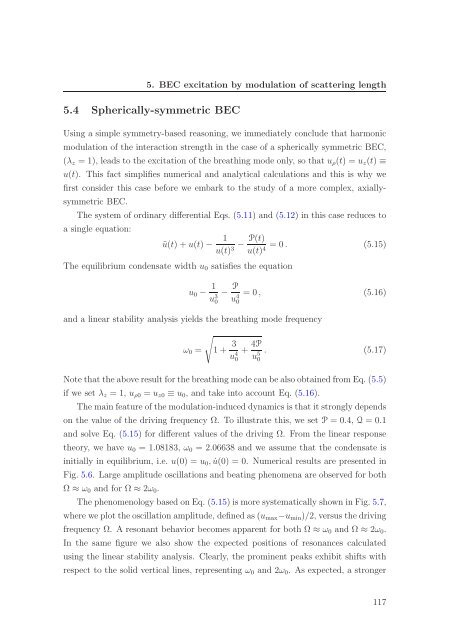PhD thesis in English
PhD thesis in English
PhD thesis in English
Create successful ePaper yourself
Turn your PDF publications into a flip-book with our unique Google optimized e-Paper software.
5. BEC excitation by modulation of scatter<strong>in</strong>g length5.4 Spherically-symmetric BECUs<strong>in</strong>g a simple symmetry-based reason<strong>in</strong>g, we immediately conclude that harmonicmodulation of the <strong>in</strong>teraction strength <strong>in</strong> the case of a spherically symmetric BEC,(λ z = 1), leads to the excitation of the breath<strong>in</strong>g mode only, so that u ρ (t) = u z (t) ≡u(t). This fact simplifies numerical and analytical calculations and this is why wefirst consider this case before we embark to the study of a more complex, axiallysymmetricBEC.The system of ord<strong>in</strong>ary differential Eqs. (5.11) and (5.12) <strong>in</strong> this case reduces toa s<strong>in</strong>gle equation:ü(t) + u(t) − 1u(t) 3 − P(t)u(t) 4 = 0 . (5.15)The equilibrium condensate width u 0 satisfies the equationu 0 − 1 u 3 0− P u 4 0= 0 , (5.16)and a l<strong>in</strong>ear stability analysis yields the breath<strong>in</strong>g mode frequencyω 0 =√1 + 3 u 4 0+ 4Pu 5 0. (5.17)Note that the above result for the breath<strong>in</strong>g mode can be also obta<strong>in</strong>ed from Eq. (5.5)if we set λ z = 1, u ρ0 = u z0 ≡ u 0 , and take <strong>in</strong>to account Eq. (5.16).The ma<strong>in</strong> feature of the modulation-<strong>in</strong>duced dynamics is that it strongly dependson the value of the driv<strong>in</strong>g frequency Ω. To illustrate this, we set P = 0.4, Q = 0.1and solve Eq. (5.15) for different values of the driv<strong>in</strong>g Ω. From the l<strong>in</strong>ear responsetheory, we have u 0 = 1.08183, ω 0 = 2.06638 and we assume that the condensate is<strong>in</strong>itially <strong>in</strong> equilibrium, i.e. u(0) = u 0 , ˙u(0) = 0. Numerical results are presented <strong>in</strong>Fig. 5.6. Large amplitude oscillations and beat<strong>in</strong>g phenomena are observed for bothΩ ≈ ω 0 and for Ω ≈ 2ω 0 .The phenomenology based on Eq. (5.15) is more systematically shown <strong>in</strong> Fig. 5.7,where we plot the oscillation amplitude, def<strong>in</strong>ed as (u max −u m<strong>in</strong> )/2, versus the driv<strong>in</strong>gfrequency Ω. A resonant behavior becomes apparent for both Ω ≈ ω 0 and Ω ≈ 2ω 0 .In the same figure we also show the expected positions of resonances calculatedus<strong>in</strong>g the l<strong>in</strong>ear stability analysis. Clearly, the prom<strong>in</strong>ent peaks exhibit shifts withrespect to the solid vertical l<strong>in</strong>es, represent<strong>in</strong>g ω 0 and 2ω 0 . As expected, a stronger117
















